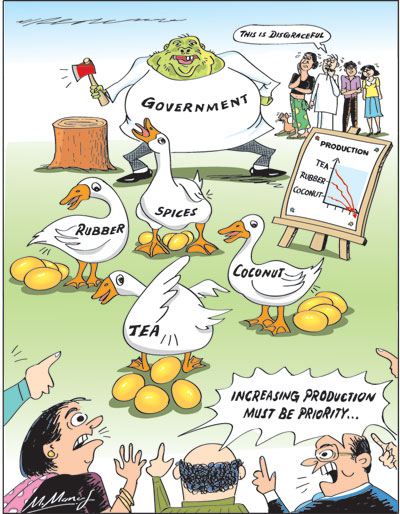Columns
Increasing export crop production vital for enhancing export earnings
View(s):Had tea, rubber, coconut and other export crop production increased in the past three decades, the economy would have been vastly better. Instead, we have been slaying the geese that were laying the golden eggs.
 Agricultural performance
Agricultural performance
While the attainment of self-sufficiency in rice is, undoubtedly, a singular achievement, the neglect of the three principal plantation crops and the underperformance of other export crops have been a colossal national failure. Export crops could have contributed significantly to the country’s export earnings. The poor performance of agricultural exports that are important foreign exchange earners has a negative effect on the performance of the economy.
Agriculture’s significance
There is a misconception of the role and significance of agriculture in economic development. The fact that agriculture’s contribution to GDP has decreased sharply is misinterpreted as an economic failure. In fact, the diminishing importance of agriculture’s contribution to GDP is a feature of economic development as it is generally brought about by the diversification of an economy by increased output of manufactures and services.
In contrast, Sri Lanka’s diminishing significance has been marked by an underperformance in export agriculture.
Developed economies
Developed economies have a small share of agriculture in GDP. Agriculture makes only a small contribution to GDP in the US that has a huge output of agriculture, dairy and livestock production. It is so with Canada, Australia and New Zealand. The latter two countries which are considered agricultural countries, too, have a modest contribution by agriculture to their national output (GDP).
The salient feature of these country’s development is that while their agricultural output increased, the share in GDP declined owing to growth of other sectors of the economy.
Sri Lanka
Sri Lanka’s growth experience is flawed by inadequate agricultural production, except in the case of rice and food crop production. Had plantation crop production also increased, then the country’s exportable surplus would have increased and contributed much more to export earnings.
Tea exports
 Tea exports were the country’s main export till industrial exports expanded after the liberalisation of the economy in 1977. The story of tea is a sad one. A sequence of government policies resulted in a decline in tea production on the plantations.
Tea exports were the country’s main export till industrial exports expanded after the liberalisation of the economy in 1977. The story of tea is a sad one. A sequence of government policies resulted in a decline in tea production on the plantations.
Taxation and nationalisation
At first it was the high taxation of export crops, then the threat of nationalisation, followed by nationalisation of estates in 1974 and poor management of state-owned plantations. These policies have been aptly described as ‘killing the goose that laid the golden eggs’.
Smallholders
Fortunately, the disaster on the estates was offset, to some extent, by the development of small holder cultivation of tea, especially in the south. In 2017, 75.4 percent of the country’s tea was produced on small holdings. Productivity on small holdings is nearly twice that on the estates. Had the tea plantations achieved their potential production, tea export earnings would have made a higher contribution to the trade balance.
Rubber
The story of rubber production in the country is somewhat similar. The difference was that depressed prices for natural rubber owing to increased production and use of synthetic rubber resulted in wide fluctuations in prices and at times natural rubber prices fell below profitable levels.
Natural rubber production has been on the decline. The area under rubber cultivation has declined owing to urbanisation and other uses of rubber land and the reduced profitability of rubber cultivation.
One of the beneficial developments in rubber is that most of the country’s rubber is used in the manufacture of rubber gloves, condoms and other rubber goods.
While the export value of natural rubber was only US$ 31.6 million, exports of rubber manufactures earned US$ 875.3 million in 2018.
Coconut
Although coconut is an export crop, most of the country’s coconut production is consumed by domestic households. The proportion of coconut consumed by households has increased sharply over the years owing to the larger population, on the one hand, and the reduced area under coconut cultivation, on the other. The latter has occurred owing to the use of coconut lands for housing, highways, industries and urbanisation. Furthermore a feature of coconut production is that about two thirds of coconut is produced in home gardens. These have also declined with population pressure. Consequently the country’s coconut oil, desiccated coconut and fresh nuts have been reduced to a paltry amount. In 2018 all coconut exports brought in only US$ 311 million.
Implications
The economic outcome of this reduction in the production of these export crops is that agricultural exports amounted to only US$ 2.58 billion or 21.7 percent of total exports. However, the significance of agricultural exports are not reflected correctly by these statistics as the domestic value addition is considerably more in agricultural exports.
The domestic value addition in tea is estimated at about 70 percent. The domestic value addition is even higher in the case of rubber — at about 80. In any event, there is a future for rubber as natural rubber could be used in the manufacture of a wide range of goods. Sri Lanka has become the world’s largest exporter of heavy duty tyres.
Outcome
The neglect of plantation crops has been a serious setback to the economy. The country has lost a significant amount of foreign exchange earnings owing to a lack of larger amounts of exportable surpluses of tea, rubber and coconut. It is imperative that the area cultivated with these crops is increased and higher yields are achieved.
Strategies
In the case of tea, there is an urgent need to increase replanting of senile tea areas with higher yielding vegetative propagated (VP) teas. The current rate of replanting of tea lands is grossly inadequate. Plantation companies and small growers must be provided with incentives to replant as uprooting senile tea areas results in a loss of crops during the gestation period. A new tea replanting subsidy scheme is urgently needed to achieve this.
The issue of inadequate labour on tea plantations must also be resolved. The Tea Research Institute (TRI) has to be strengthened with quality research scientists and a research prioritisation that responds to the industry’s needs.
Rubber cultivation
The effective implementation of the Rubber Master Plan is vital. The current status of this plan is one of slow implementation. The initiatives to expand rubber cultivation in new areas such as Moneragala is a good move.
Coconut cultivation
It is vital to increase the area under coconut cultivation to enhance production. There are areas suitable for coconut in the Northern and Eastern part of the country. They must be exploited. Issues of land ownership must be resolved to enable a new wave of coconut cultivation in the country.
Conclusion
Increased production of export agriculture is vital for improving the country’s trade balance, balance of payments and economic stability and growth.


Leave a Reply
Post Comment